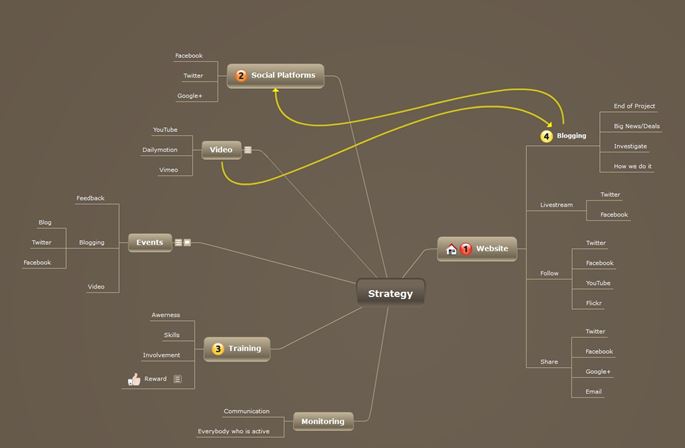By Rogier Noort, {grow} Community Member
In the past 20 months I learned so much about Social Media and Social Business it’s just ridiculous. All the available information in blogs like {grow}, books, conferences, e-books, newsletters is almost overwhelming.
When I moved to Belgium I needed a new job and I had just one requirement — it needed to have a Social Media element in it.
I was, and still am, the Go-To Social Media guy for my friends and family and thought I knew it all a lot. With that attitude I went on a job interview in Brussels and, lo and behold, I actually got a job.
Good for me.., but now it was time to put my money where my mouth was.
The Strategy
I started with the Social Media Strategy … because that’s what you do, right?
My strategy did not have much to do with content creation, however. What I did was figure out where I wanted to end up, what my personal, ideal view on the use of social media was … based on the books and blog posts I had read.
It was a bit too … ambitious.
The company I worked for had 200 employees, supplied local customers in the Brussels region and has an old-school command-and-control culture.
There were other issues. All departments happily existed within their own silos, quite a few employees are permanently stationed at a remote client location and I was a stranger from another country who did not know the language well (it’s French, if you want to know, and although Brussels is supposed to be bilingual, it really isn’t).
I was realizing I did not have a strategy issue, I was facing a culture issue.
No Control
My first lesson was this: as a social media professional you depend on other people and departments to get things done.
Updating the corporate website, my first step in the strategy, was almost completely out of my control. Add to this a reduced budget, decentralized content-management, in-house web developers (who do not want to give up any control) and an overall priority for client websites and change becomes an arduous process.
It took me more than a year to feel like some changes were being implemented.
No Leadership = No Participation
My second lesson — A green light from management does not equal success.
Active management sponsorship is crucial for the success of a social strategy, or any business strategy for that matter.
I argued and pleaded and tried to convince employees to participate, but to no avail. The most involvement I got were two ghost-written blog posts. These were, in effect, of no consequence. They did not even relate to the company or solved any problem a client might have.
There was no executive leadership and that led to a lack of trickle-down-participation.
No Content Creators
The third lesson I learned was, creating great content is hard work.
It’s tough enough for a personal blog, but it is significantly more challenging for a multi-author corporate blog, especially when you are the only one pushing things along.
I learned that creating an editorial calendar is no guarantee deadlines are met. Even though our seven “regular” bloggers knew their topic and their deadline (I put these in their calendars), everybody always waited until the last possible moment.
And more often than not, I received an email the day before, “Sorry, but I can’t make it … No time.”
I ended up writing a bunch of posts to fill in the gaps. Oh well. I suppose this was good practice for me!
No IT Support
Although Social Media is not about hardware and computers, I learned that you don’t get anywhere without IT support.
To make progress, I needed a blog … something more than a Twitter account and a company Facebook page.
I tried to get blog functionality on our corporate website. This turned out to be too much of technological challenge. I argued that it wasn’t (Google was my supportive friend here), but, I hit a wall of IT obstinance.
In the end, I set up a WordPress blog on my own.
By the time I left the company we had just about 80 posts, some really good, and we had a reasonable amount of visitors, but not much more than that. There was no measurable ROI or business benefit.
I’m to Blame
Now, it may look like I’m pointing the finger at management, IT and everyone else who was supposed to support me … and it’s true that they probably could have gotten behind the program a bit more.
But the truth is, my strategy was doomed from the beginning.
I created something based on what I read on the web, not based in reality. I ticked off the list with things other people told me I would need. I did not take the company culture into account. I did not secure executive sponsorship. I did not look at realistic, measurable goals based on the capabilities of the company. I did not create a compelling story for what I was trying to accomplish and I did not use the company business plan as a guide.
I just started. And I won’t make that mistake again.
Key lessons
- A strategy without executive sponsorship is meaningless.
- The corporate culture dictates social media capabilities and competencies, not my will.
- There is no cookie-cutter approach from books and blog posts.
- I’ll never get the support I need without active management understanding and participation.
- I need to make a case for social media based on a business plan, in the language of the company.
What about you? Is there one mistake you made from which we can learn? Please share, I’d like to know so I don’t feel so alone out here!
 As a social entrepreneur in the BeNeLux my focus lies on a holistic approach for helping companies mature their social media exploits, externally and/or internally. Find me on Twitter (@rogiernoort), LinkedIn (be.linkedin.com/in/rogiernoort/) or on my blog, where I write about social business in Western Europe.
As a social entrepreneur in the BeNeLux my focus lies on a holistic approach for helping companies mature their social media exploits, externally and/or internally. Find me on Twitter (@rogiernoort), LinkedIn (be.linkedin.com/in/rogiernoort/) or on my blog, where I write about social business in Western Europe.
Illustration courtesy BigStock.com




